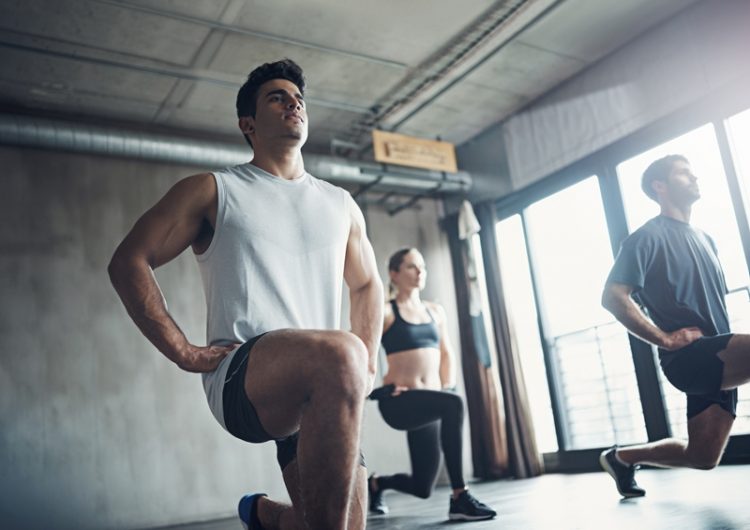By
The lunge is a versatile, simple and effective movement for lower body training. Various positions, planes of motion and speeds can all yield different training adaptations for the exerciser. Lunges are the gift that keeps on giving! We’ll discuss different tweaks, twists and turns that change the demand on the kinetic chain; and that keep your clients’ workouts interesting and effective.
TWO BASIC LUNGE POSITIONS
First, let’s review what a lunge is. A lunge is very much a “squat with a kickstand.” The best way to feel this idea is to take yourself to the bottom of your squat, hold, and take one foot and step back. There you have it.
There are a couple basic lunge positions that apply to most variations: one with an upright trunk and one with a slight forward lean of the trunk. Let’s look at how these positions differ in their demand on the lower body.
The Upright Lunge – An upright trunk tends to create what is often called a 90/90 lunge where both knees at the bottom of the move are 90° angles. With this positioning, the majority of a person’s upper body weight is situated directly over their hips. From what we know about biomechanics, the joint farthest away from load will receive a majority of the stress. So, in an upright lunge, the forward knee will experience more torque because it is the joint farthest from the load of the body. Therefore, the knee extensors will bear more responsibility. Bottom line: If the exerciser’s trunk is upright and performing a 90/90 lunge, it is a more quadriceps dominant movement.
The Forward Leaning Lunge – When an exerciser leans slightly forward with their upper body weight positioned over the mid-thigh, demand will be evenly distributed across the hip, knee and ankle. Again, using our biomechanical principles, if the primary load is positioned in between two joints (in this case the hip and knee), the muscles moving those joints through extension will both bear responsibility in the exercise. Bottom line: A slight forward lean increases glute involvement.
FURTHER INCREASING GLUTE INVOLVEMENT
Twist to Open! We can further increase gluteus maximus involvement by adding trunk rotation. Remember that the gluteus maximus concentrically performs hip extension and external rotation. An exerciser can eccentrically load the gluteus maximus in the sagittal and transverse planes by leaning forward (hip flexion) and rotate the trunk toward the forward leg (hip internal rotation). By loading the glutes eccentrically in both of these planes, we increase the demand for them and therefore increase their response. For example, if performing a lunge with the left foot forward, you would rotate the right shoulder toward the left knee. To maximize glute involvement, be sure that you don’t lift your forward heel off the ground while decelerating toward the floor. Aim to have your weight distributed evenly across the forward foot.
MULTIPLANAR LUNGES
Multiplanar lunges are a great way to mix things up! From what we know about the training principle of specificity, our bodies respond very specifically to the stimulus presented in a workout. Research further supports that the directionality of forces applied to the kinetic chain impact how the body responds. For example, loading the body laterally (such as in a shuffle pattern or lateral lunge) selectively improves its proficiency in the frontal plane. The bottom line here is that we definitely want to work in multiple planes and multiple joint angles to maximize a client’s training.
Tips for executing multiplanar lunges:
- Solid hip-knee-ankle mechanics apply here just like they do in squatting motions. Make sure that alignment is prioritized during multiplanar lunges.
- Start a client in the plane they are most comfortable in. For many clients, this is the sagittal plane. Remember we want our clients to feel confident before we begin to push them into new directions as they improve.
- Don’t take strides that are too long. People have a tendency to use momentum to propel themselves up if the step is too long. Start with a shorter step to ensure control is maintained throughout the entire range of motion.
- Try reaching toward the ground with your hands as you step (usually applies to bodyweight or dumbbell lunges). This helps to soften the landing of each step and reinforce eccentric control. You can also use your client’s reach to efficiently guide them into different planes (e.g., have them reach for 12:00 or 9:00 as if they are standing in the centre of an imaginary clock).
BRINGING IT ALL TOGETHER
No matter how you combine the variations discussed here, make sure technique and posture are maintained. Lunges are a great part of your client’s progressive and challenging program design and can be modified for any fitness level. And importantly, the variations presented here can keep your client (and you) from getting bored!

